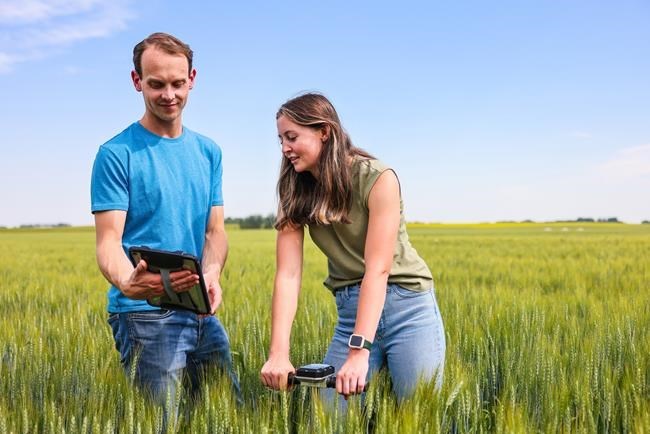Canada’s farmers are getting older, and most don't have a clear succession plan, leaving a big question over who will take over the agriculture sector as a wave of retirements loom.
But industry insiders say an increased focus on technology and sustainability is helping attract younger generations to agriculture, including those coming to the field for the first time.
Young people entering farming from other industries will be key to the sector’s evolution as it grapples with challenges like climate change, said Todd Klink, chief marketing officer at Farm Credit Canada.
“We're going to need technology, we're going to need innovation, we're going to need new ideas and new approaches," he said. "So when you meet young people that have these new ideas and come from different disciplines, it's super exciting."
The demographics of farm operators show an industry in clear need of rejuvenation, even as the barriers to entry can be daunting.
The average age of a Canadian farm operator was 56 in 2021, according to Statistics Canada, and the median age 58, with both those figures rising from the previous census. More than 40 per cent of those operators plan to retire over the next decade, according to a report from the Royal Bank of Canada, Boston Consulting Group Centre for Canada’s Future and Arrell Food Institute at the University of Guelph.
While some will pass the business on to their children — 12 per cent of farms told Statistics Canada they had a succession plan in 2021 — it’s no easy feat to buy or sell a farm, nor to start one from scratch, due to the high costs of land and equipment, as well as the fact that over time, farms have consolidated and therefore gotten bigger on average.
“Unless you're inheriting or you're part of a succession plan for an existing farm ... it’s nearly impossible to get into it from the ground up,” said Joy Agnew, vice president of research at the Olds College of Agriculture and Technology in Alberta.
Money isn’t the only barrier for attracting the younger generations into agriculture, said Agnew. There are perceptions that farming is hard, dirty work that makes no money, she said — even though agriculture contains a wide range of jobs that don’t look like stereotypical farm work, and most of them don’t involve buying or inheriting a farm.
But as farms adopt more technology such as automated steering and drones, the college has seen increased interest, she said.
“We're seeing more and more young people in those very niche technological areas like software development or coding or instrumentation or robotics,” said Agnew. “They’re now seeing careers for themselves in the (agriculture) sector.”
Alongside the technological shift, farmers are increasingly adopting sustainable practices, Statistics Canada says, using practices like cover crops and no-till agriculture in efforts to mitigate climate change.
Younger generations are showing more interest in sustainable practices, including ways to maximize yields from smaller farms that are more financially accessible.
Georges Boudreau and his partner Béatrice Cloutier-Hébert established Ferme La Chaleureuse in Carleton-sur-mer, Que. last year. Using less than two acres, the pair deploy a technique called bio-intensive farming, which focuses on maximizing the yield of a small piece of land. Boudreau learned the technique at La Ferme des Quatre-Temps in Hemmingford, Que., which trains young farmers in addition to growing and selling produce.
Boudreau said while there will always be a need for large farms, he sees growing interest in smaller farms that feed their nearby communities.
"That's what I think is the future. Less industrial farming and more community and smaller farms."
And in an effort to grow more local food year-round, there's another trend set to help fill the gap: indoor farming, whether in greenhouses or vertical farms. The total area of greenhouses in Canada grew by more than 23 per cent in 2021 compared with 2016.
Barry Murchie founded GoodLeaf Farms in 2011 after working in food for several decades, including at McCain Foods for 25 years. GoodLeaf's production of leafy greens and micro greens is currently centred in Guelph, with facilities in Calgary and Montreal set to open this summer.
Murchie said the technology underpinning vertical farming is allowing for a new kind of agriculture that can take place in urban centres. GoodLeaf’s employees come from a range of backgrounds, with average ages in the 30s, and tend to be concerned about the environment and the food supply chain, he said.
"We have people who are sort of early in their careers making decisions to come and join GoodLeaf," said Murchie. "They want to work in an environment that they feel that what they're doing is beneficial for the planet."
Growing public scrutiny of where food comes from is generating more interest in the agriculture industry among younger generations, said Dustin Farr, an instructor of agriculture management and precision agriculture at the Werklund School of Agriculture Technology, which is part of Olds College.
As a result, Farr said he’s seeing more and more students coming to agriculture from increasingly diverse backgrounds. He says that while he's well aware of the challenges facing the industry, his students leave him feeling optimistic.
“We have some brilliant minds that are coming into agriculture.”
This report by The Canadian Press was first published May 22, 2023.
Rosa Saba, The Canadian Press




